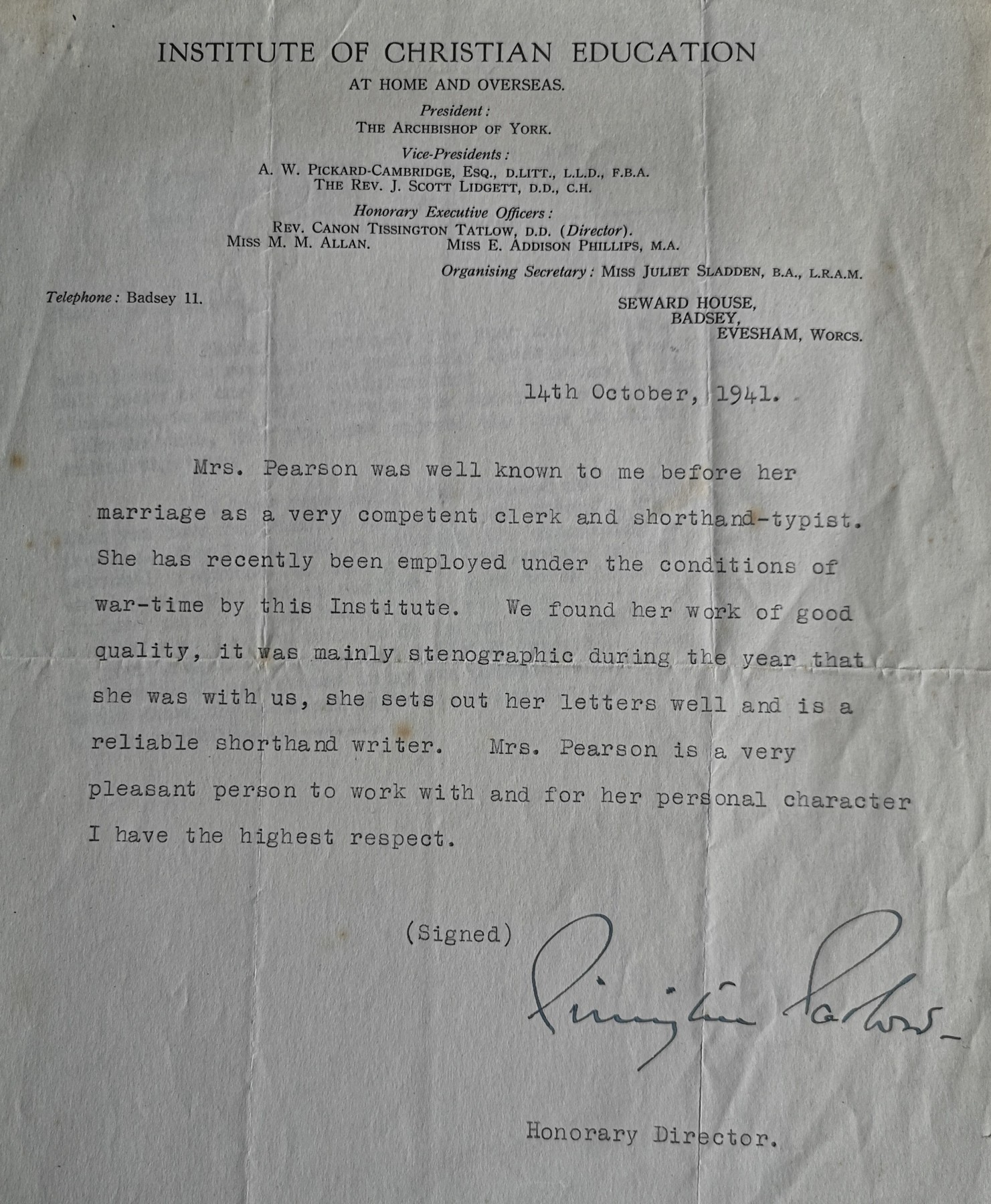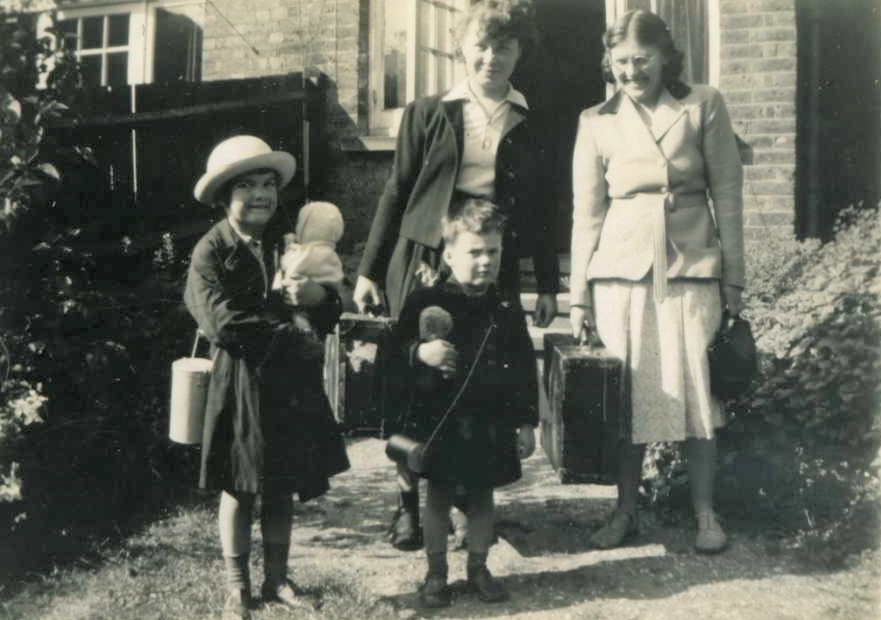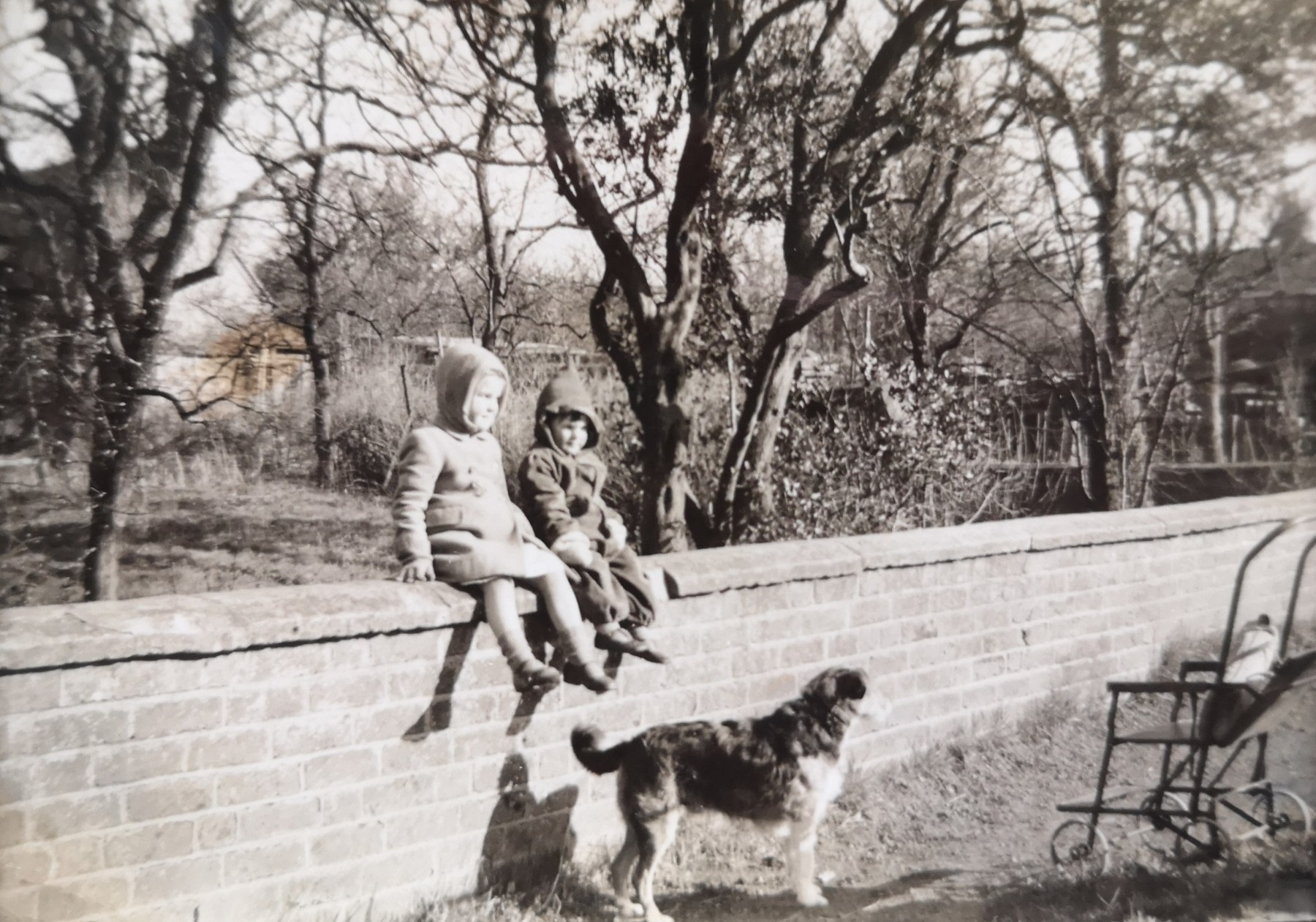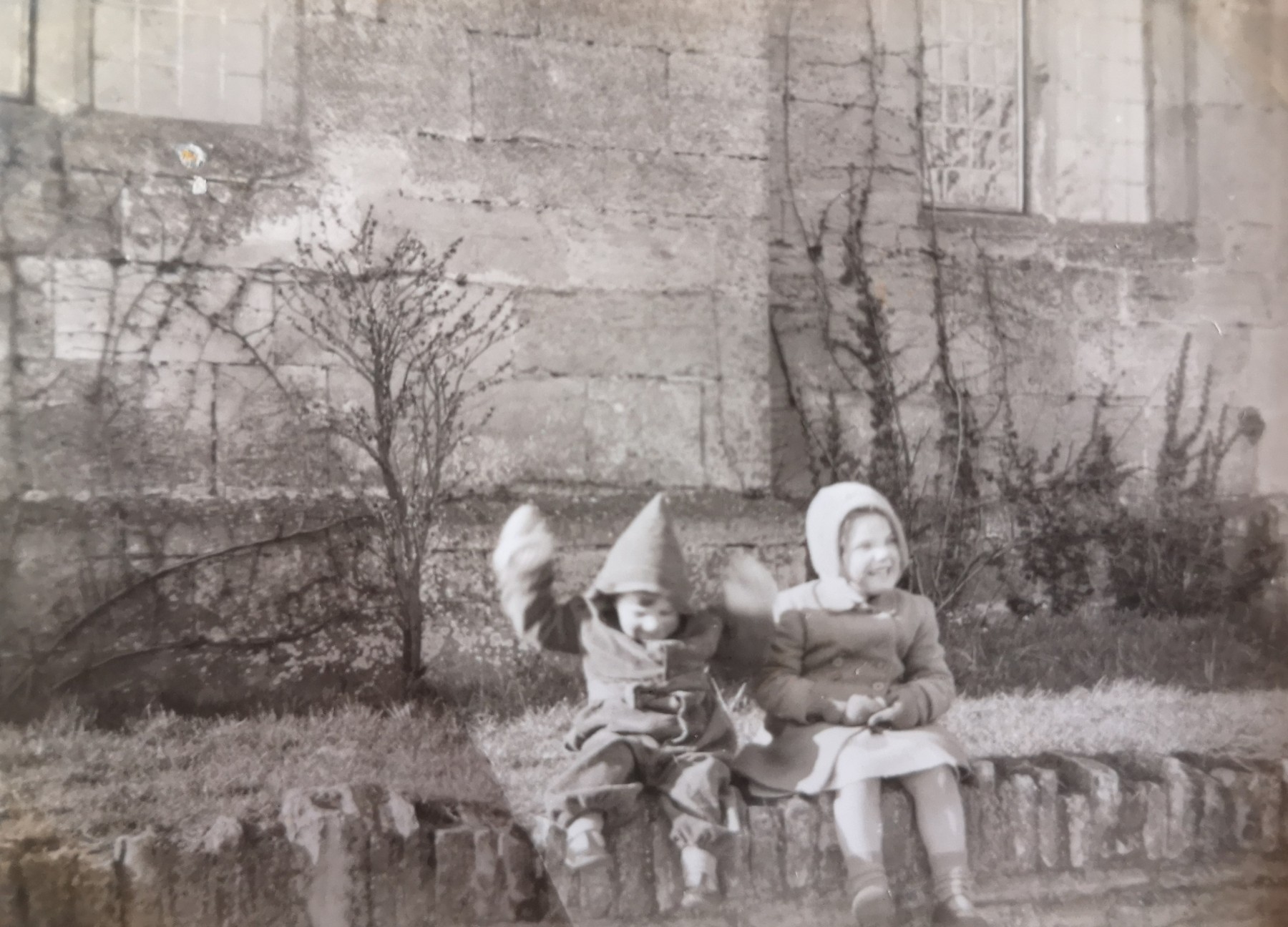By a strange coincidence, Liz Pearson Mann, who is to come and speak to The Badsey Society in January 2023 about the archaeology of food and the farmed landscape, wrote to say that she had a very slight link with Badsey. Her father and aunt, Nicholas and Cathy Pearson, were evacuated to Badsey from Wimbledon during the Second World War. Liz was aware of the Sladden letters on our website and wondered if the Sladden family were active in arranging evacuees as she had a letter with Juliet Sladden’s name on it and with a Badsey phone number. Juliet Sladden was secretary of a Christian organisation that Liz’s grandmother had worked for in London. Liz wondered if this might be why her father and aunt came to Badsey.
So what was the connection between the Pearson and Sladden families and what was the Christian organisation?
* * * * *
The Institute of Christian Education at Home and Overseas
During the Second World War, it was not just children that were evacuated to Badsey. An organisation called The Institute of Christian Education at Home and Overseas moved its headquarters from 49 Gordon Square, London, to Seward House, Badsey. The reason for this was that the Secretary of the organisation was Miss Juliet Sladden who had grown up in Badsey.
Juliet Elizabeth Sladden had been born at Seward House on 20th November 1897, the youngest of eight children of Sir Julius Sladden and his wife, Eugénie. Her mother had died in 1916 and her father in 1928, but two of her sisters, May and Ethel Sladden, still lived in the family home. On the outbreak of war, the Misses Sladden invited the Institute to relocate to Badsey.
Thus Juliet returned home to Badsey with hundreds of books, innumerable files, a mass of office equipment and in the company of the Director, Dr Tissington Tatlow. The 1939 Register, taken on 29th September 1939, reveals that Juliet and Dr Tatlow and his wife were already in Badsey. Juliet and her sisters lived in the main part of Seward House (current-day No 24A High Street) and the Tatlows in the more northerly section (current-day No 24B High Street).
The Institute of Christian Education at Home and Overseas had been formed in June 1935 with the Archbishop of York, Dr Temple, as President and Dr Tissington Tatlow as Honorary Director. Juliet Sladden had been involved with the Institute since its inception as Organizing Secretary. Its aim was “to combat scepticism and paganism, to make religious instruction more efficient, and to undertake work of religious research and study.” The raison d’etre of the Institute was stated in an explanatory leaflet:
The Christian foundations of western civilisation are being sharply challenged by new secular forces and it is clear that the mind of the nation needs to be gripped by the Christian Faith in a new way if our country is to maintain a Christian basis for its life. There is increasing concern about the place of religion in education and there is also increasing uncertainty and confusion of thought among teachers.
The Institute sets itself to meet the need for study and research on the fundamental problems of Christian education and to give systematic help to Christian teachers and leaders of youth. That it means business is apparent from a glance at its list of officers.
By 1941, according to a report in the Coventry Evening Telegraph, there were 20 associations, some representing a whole county, affiliated to the Institute. With a view to starting a Warwickshire Association, a meeting composed mostly of teachers and clergy was held at Leamington High School for Girls on 18th October 1941. Dr Tatlow spoke of a census taken at a day school which revealed that 96% of the children were never taken to chapel or church by their parents. The Institute dealt with all sorts of problems relating to the teaching of religion in schools, and very valuable work had been accomplished.
When the war ended in 1945, the Institute and its staff was able to return to London.
The Pearson Family
One of the people who worked for The Institute of Christian Education at Home and Overseas was Mrs Estelle Nancy Pearson (née Collins). Estelle had married Edward Leonard Pearson in 1934 and had two children, Catherine Ann (born 3rd June 1937) and Nicholas David (born 10th March 1939).
A reference letter written by Tissington Tatlow on 14th October 1941 on Institute of Christian Education headed notepaper, then based at Seward House, Badsey, reveals that Estelle Pearson had worked for Canon Tatlow before her marriage and, for the past year, had been employed by the Institute.

Mrs Pearson was well known to me before her marriage as a very competent clerk and shorthand-typist. She has recently been employed under the conditions of war-time by this Institue. We found her work of good quality, it was mainly stenographic during the year that she was with us, she sets out her letters well and is a reliable shorthand writer. Mrs Pearson is a very pleasant person to work with and for her personal character I have the highest respect.
Tissington Tatlow, Honorary Director.
One person who has memories of the Pearsons in Badsey is nonagenarian Sheila Knight (née Butler). Sheila (born July 1925) was the daughter of Arthur & Zillah Butler. On leaving Miss Morris’ private school in Evesham, Sheila was in charge of the kindergarten class in the morning and in the afternoon acted as nursemaid to Cathy and Nicky Pearson. She said that the Pearsons lodged at the Wheatleys’ house (this was the home of widow, Lucy Wheatley, and was next-door to Seward House). Mrs Pearson worked in the office at Seward House but Mr Pearson could not work as he had TB.
On leaving the employment of the Institute of Christian Education, Estelle Pearson went to work for the Czech Embassy as secretary to the Head of the Cultural Relations Division of the Information Department. A letter from the Minister, Dr František Černý, written on 31st August 1945, reveals that Mrs Pearson remained at the Embassy until the end of the war, only being released in consequence of the Ministry transferring to Prague and the closing of its London offices.
Even though Estelle had ceased working for the Institute in 1941, she obviously kept in touch with folks in Badsey as, in 1944, she sent her children to the village – presumably felt it was safest if they were evacuated from London. The Badsey Council School admissions register reveals that Catherine and Nicholas Pearson attended the school for a few weeks in September 1944 and that their address was care of Mrs Butler, Badsey. This was Sheila Butler’s mother, Zillah, who lived with her husband, Arthur, and family at Chalcroft, 16 Old Post Office Lane. Cathy Pearson remembers this as being a smallholding not far from the school which they walked to across a field. Nicholas Pearson recalled that they had a disabled son, which he thought might have been caused by a condition like cerebral palsy. [The son was James Hemmingway Butler, 1919-1967, who had suffered from infantile paralysis and meningitis as a child.]



Cathy and Nicholas returned to their home at 8 Worple Road, Wimbledon, in late September 1944 as their mother missed them so much. Their father died shortly after the war had ended, in January 1946.
Cathy Pearson’s memory of her time in Badsey was that her mother had remained in London, whereas Sheila Butler definitely spoke as if Mrs Pearson was resident in Badsey. The discrepancy may perhaps be accounted for by the fact that there were probably two separate occasions when the Pearsons were in Badsey: in 1941 when the children were still very young and had no memory of their mother working at Seward House, and in 1944 when they were probably sent away by themselves to Badsey.
Mrs Pearson asked Sheila to go with them to London, but Sheila’s parents did not want her to go. It was thought at first that this was in 1944 because of the buzz bombs (doodle bugs) which were first launched on London in June 1944, but it was probably more likely to have been in 1941, as by 1944, Sheila had joined the Land Army and moved away from Badsey.
Canon Tissington Tatlow (1876-1957)
Dr Tissington Tatlow, together with his wife, spent the six years of the Second World War living in Badsey. During this time, not only did he continue with his work in connection with the Institute of Christian Education, but he also became involved in the life of the community, helping out with church services at St James’ Church, Badsey, in the declining years of the incumbent, Canon W C Allsebrook, and also at churches in Evesham: St Laurence, All Saints and St Peter’s, Bengeworth.
Tissington Tatlow was originally from Ireland, born on 11th January 1876 at Crossdoney, County Cavan, the eldest son of William Tissington Garnett Tatlow, land agent to Lord Kingston's estate, and his wife, Blanche, daughter of Thomas Steuart Townsend, who was bishop of Meath 1850-52. Tatlow was educated at St Columba's College, Rathfarnham, and in the engineering school of Trinity College, Dublin. On graduating in 1897, he decided to become a foreign missionary and became travelling secretary of the recently formed Student Volunteer Missionary Union (subsequently renamed the Student Christian Movement – SCM). A year later he was appointed secretary of its associated body, the British College Christian Union.
In 1900, Tatlow returned to Trinity College, this time to the divinity school. He was ordained deacon in 1902 and priest in 1904. In 1902 he became curate at St Barnabas, Kensington, and in the following year married Emily, daughter of Richard Scott, a Dublin insurance manager. The couple had three daughters: Ethne Cecilia Tissington (1907-1910), Phyllis Angel (1909-2005) and Barbara Elizabeth (1914-2013). By 1911 they were living at 31 Templars Avenue, Golders Green, which was to remain the family home for the rest of their lives.
From 1903, Tatlow was General Secretary of SCM, a post which he held until 1929. He travelled widely to visit colleges and universities in Europe and America as well as the UK, and took a leading part in the life of the World's Student Christian Federation. He was founder in 1912 of the influential Anglican Fellowship. Other appointments included rector of All Hallows, Lombard Street (1926), rector of St Edmund, King and Martyr (1937), both in London, honorary canon of Canterbury (1926), honorary fellow and treasurer and later president of Sion College. In addition to the normal work of a City parish he made his church a centre for students and teachers. In 1925 Edinburgh University made him an honorary Doctor of Divinity.
For over 20 years, from 1935 until his death, Tissington Tatlow was Honorary Director of The Institute of Christian Education, giving outstanding leadership in its work of promoting the cause of Christian education in the UK and overseas. His name soon became as well known among the schools as it had been for years in the universities.
During the war, the Tatlows’ two surviving daughters both married. Barbara, the younger daughter, married Michael Staffurth Stancliffe at Oxford on 12th December 1940. Ten days later her husband was ordained a deacon at Salisbury Cathedral. Phyllis, the older daughter, married Herbert Bruno Paul Lieske, a German refugee, in London on 24th July 1943. The following January, Herbert, who was described in newspaper reports as “a friendly German refugee”, was appointed art master at Gainsborough Boys’ Grammar School in Lincolnshire. He had thrice been imprisoned in Nazi Germany in the 1930s and had succeeded in reaching England in February 1939.
Tissington and Emily Tatlow returned to their home at Golders Green some time during the summer of 1945. They were still in Badsey on Sunday 13th May 1945 when there was a day of National Prayer. An article in The Evesham Standard records that Canon Tissington Tatlow gave the address at a special thanksgiving service in St James’ Church.
Tatlow died there on 3rd October 1957, aged 81. The November 1957 issue of the Badsey Parish Magazine reported on his death:
The news of the death of Canon Tissington Tatlow was received with regret by his friends in Badsey. On Sunday October 13th I made reference to his long and distinguished service in the Ministry, especially his work for the Student Christian Movement and the Institute of Christian Education. We must always be grateful for the help he rendered in the matter of Church Services during Canon Allsebrook’s illness and at other times. W.B.C.
Juliet Sladden’s Retirement
An article in “Religion in Education”, Volume 28, Issue 1, 1960, noted Juliet Sladden’s retirement from The Institute of Christian Education:
Many members of the Institute will already know that our invaluable General Secretary, Miss Juliet Sladden, is retiring on 31 December 1960. She has served the Institute for over 25 years, first as Organizing Secretary under Canon Tatlow as Director, and for the last ten years as General Secretary. In this capacity she has carried the whole weight of responsibility for the general office and headquarters of the Institute, and as Secretary to the Council and the Executive Committee has been the person who has exercised a leading and a guiding influence upon the whole work of the Institute. All who have known her, and these must number a very large proportion of the membership, will wish to thank her with the deepest sincerity for the wonderful and self-sacrificing work which she has done for the Institute and for the whole cause of Christian education.
On retirement, Juliet returned to live in Badsey at Seward House, dying there in October 1984, aged 86.
Maureen Spinks, May 2022
Acknowledgements
With thanks to Liz Pearson Mann (granddaughter of Estelle Pearson who worked for the Institute) for supplying copies of the photographs of her family, and whose email was the trigger for this article.
